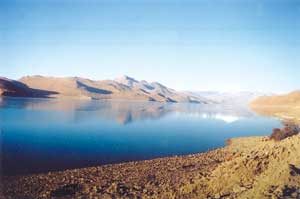 Ever since Tibet was opened to the world, it has never been the same again. Neither has the world. This is the roof of the world, with breath-taking scenery that is almost celestial. If there is a part of you that seeks adventure and places so exotic that they need more than words to be described, then this is the place for you-the landscape, the pilgrims, the magnificent architecture of the monasteries. And above all, the sky. The sky.
Ever since Tibet was opened to the world, it has never been the same again. Neither has the world. This is the roof of the world, with breath-taking scenery that is almost celestial. If there is a part of you that seeks adventure and places so exotic that they need more than words to be described, then this is the place for you-the landscape, the pilgrims, the magnificent architecture of the monasteries. And above all, the sky. The sky. More than most journeys, this is one that benefits from preparation. Improvising along the way is fine, of course, but in Tibet some prior knowledge makes your travels a lot more fruitful and enjoyable. A recent six-month stay in Tibet taught me some things well worth knowing, and it may save you some time and hassle to know them, too.

Where to begin
The Chinese Embassy in Kathmandu is open for visa applications Mondays, Wednesdays and Fridays, from 10AM-11.30 AM. The screening process is not too difficult, and you can come back for your visa. If you simply can't wait, the embassy will give you a visa the same day, or three days later, for express processing. Due to the short timeframe, just an hour and a half, getting to the embassy early is always recommended, and it is also good to know that groups of four and above have a greater chance of getting a visa. The visa can cost anywhere from Rs 2,200 to $56, depending on your nationality, whether you're applying in a group, and how fast you need it.
 Someone to watch over you
Someone to watch over you The idea of travelling independently might sound tempting in comparison with the prospect of a travel agency watching your every move. But things work a little differently in the Tibet Autonomous Region, and it is definitely easier to negotiate all those checkposts with an insider, instead of having to answer a million questions and having your discman, books, camcorder, dictaphone, visiting cards, photographs of family-everything-come under long, time-wasting scrutiny. So do yourself a favour and get yourself a travel agent. You're listed, and everybody's happy.
Hit the road
It's a thrill to cut through vast expanses of the country on wide, open roads. Sure, there's dust, but hat, mask and shades solve that problem. The landscape is never static. Moving across this pastoral plateau in their time-honoured pace are nomads, mastiffs, herds of yak and sheep dotting the hills, horses grazing, birds flying a feet above the ground, wild antelopes and hares scurrying right past you, rolling hills, and crazy cloud formations in blue skies. (That's why thangka clouds look like that.) You don't even have to take the same route twice. If it's Zhangmou, Tingri, Lhatse, Shigatse and Tsethang on your way to Lhasa, on your way it could be Tsethang, across Khamba La to Yamdo by the shores of the aptly-named Yamdo Yutso (the Turqoise Lake), Gyantse and Shigatse. And if you're lucky you could just happen upon a breathtaking panoramic view of the Himalaya, including Mt Everest from the north. Travelling by road also solves the problem of altitude sickness and provides many, many photo-ops.
 Traces of Nepal
Traces of Nepal Newari traders from Kathmandu have long left their second home, but you can still see traces of history. The Ramoche temple in Lhasa is probably the oldest reminder of the link between Nepal and Tibet. The idol of the 10-year-old Sakyamuni here was a gift from Bhrikuti, the Newari princess, to Songsten Gompo. The Jhokhang's architecture also has some distinctly Newari touches. And if you miss daal bhaat, just go to the Snow Lion Restaurant on the outskirts of Barkhor on Mentsekhang Road. Not just daal bhaat, here you'll get aloo dum, aloo sandeko, kalo daal and - well, you get the idea. There is even a Nepali consulate not far from the
city centre.
Lhasa locals also have a taste for Nepali chia. Maybe it isn't as strong as we're used to it here, but it is wonderful to be able to drink the familiar sweet, milky tea in dingy restaurants. The tea is served in little yellow glasses, so it always needs several cups to really get into it. Waitresses come around, fill up an empty glass and collect the money that's already placed on the table. They do this constantly, as long as you're sitting there.
Nature calls
Be prepared to venture out into the wilderness-toilets aren't exactly on the top of the government's to-do list. There are a few public toilets, but not nearly enough, and even residences, especially in the Kiray area of old Lhasa, have significantly poor toilet facilities. And as you move out of Lhasa, irrigating the arid plateau is about your only option.
Shopping, anyone?
You will weep when you see the prices on electronic goods, because you can't possibly take back as much as you'd like. VCDs, DVDs are literally given away. And then there's great music to be had for about 10 Yuan (just about Rs 100) per CD. From Velvet Underground to the Cranberries to the soundtrack to The Godfather. Just make sure you keep some money for the customs checkpost at Kodari, and some energy to argue with the security forces on the Nepali side at numerous checkposts on the way to Kathmandu.


